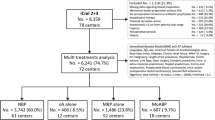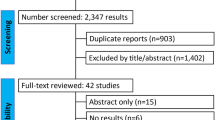Abstract
Intraoperative testing (IT) is used to confirm the integrity of gastrointestinal anastomosis. Clinical trials are available in the literature to support the fact that methylene blue can identify the leaks, and can thus help in minimizing the postoperative ratio of clinical leaks after total gastrectomy. In the recent literature, machine learning tools have been used very successfully to investigate the hypothesis of such complex clinical trials, where incomplete data is available. In this article, data obtained from a clinical study, is analyzed using machine learning, to verify whether or not the methylene blue test can accurately identify the leaks and to predict future outcomes. Furthermore, a comparative study based on most robust machine learning solvers is presented in this article to identify the most appropriate machine learning technique(s) for future applications. We have considered the data (over a period starting from Jan 2007 till Dec 2014) based on the total gastrostomies (TG), where methylene blue test was applied. Data was obtained from 198 patients having gastric cancer. Out of 198, 108 cases went through methylene blue test done by a nasojejunal tube while no test was carried out for rest of 90 cases. Intraoperative leakage rate, mortality rate, length of hospitalization and postoperative clinical leakage rate were the measured outcomes. To analyze the data and to predict whether there will be a leak or not, machine learning techniques were applied and the accuracy was compared. The main objective of this research is to predict the clinical leakage after applying methylene blue test on gastric cancer patients. This objective is successfully achieved by implementing six machine learning approaches. Case specific machine learning approaches are discussed to evaluate post clinical leakage rate and radio leakage rate. From our analysis, we have concluded that the prediction of intraoperative leak, post clinical leak and radio leak is possible with the aid of different machine learning techniques. An important conclusion drawn from this study is that a single machine learning technique can not accurately predict different stages of leak, since the accuracy of the technique depends on the specification of clinical data that varies from stage to stage.





Similar content being viewed by others
References
Marek V, Durdik Š (2017) Gastric cancer with liver metastasis (gclm) and the importance of dormant cancer stem cells, in Gastric Cancer, InTech
Alici S, İzmirli M, Doğan E. Yüzüncü yıl üniversitesi tıp fakültesi tıbbi onkoloji bilim dalı’na başvuran kanser hastalarının epidemiyolojik değerlendirilmesi. Türk Onkoloji Dergisi. 2016;21(2):87–97.
Artac M (2016) “gicasym.org/state-cancer-care-turkey,” tech. rep.
Celik S, Almalı N, Aras A, Yılmaz Ö, Kızıltan R. Intraoperatively testing the anastomotic integrity of esophagojejunostomy using methylene blue. Scand J Surg. 2017;106(1):62–7.
Migita K, Takayama T, Matsumoto S, Wakatsuki K, Enomoto K, Tanaka T, et al. Risk factors for esophagojejunal anastomotic leakage after elective gastrectomy for gastric cancer. J Gastrointest Surg. 2012;16(9):1659–65.
Tegels JJ, De Maat MF, Hulsewé KW, Hoofwijk AG, Stoot JH. Improving the outcomes in gastric cancer surgery. World J Gastroenterol: WJG. 2014;20(38):13692.
Hinton GE, Osindero S, Teh Y-W. A fast learning algorithm for deep belief nets. Neural Comput. 2006;18(7):1527–54.
Sohail A, Li Z (2018) Computational approaches in biomedical Nano-engineering. John Wiley & Sons
Popivanov G, Tabakov M, Mantese G, Cirocchi R, Piccinini I, D’Andrea V, Covarelli P, Boselli C, Barberini F, Tabola R, Pietro U (2018) Surgical treatment of gastrointestinal stromal tumors of the duodenum: a literature review. Translational gastroenterology and hepatology, 3
Giuliani A, Romano L, Papale E, Puccica I, Di MF, Salvatorelli A, Cianca G, Schietroma M, Amicucci G (2019) Complications post-laparoscopic sleeve gastric resection: review of surgical technique. Minerva Chir
Agbelusi O (2014) “Development of a predictive model for survival of hiv/aids patients in south-western nigeria,” Unpublished MPhil Thesis, Obafemi Awolowo University, Ile-Ife, Nigeria
Kourou K, Exarchos TP, Exarchos KP, Karamouzis MV, Fotiadis DI. Machine learning applications in cancer prognosis and prediction. Computational and structural biotechnology journal. 2015;13:8–17.
Byrne M, Abu-Rustum N, Usiak S, Frame J, Aslam A, Ogden S, et al. Risk prediction model for surgical site infections in patients undergoing open gynecologic cancer surgery following the implementation of a reduction bundle at a comprehensive cancer center. Gynecol Oncol. 2018;149:215.
Abdel-Zaher AM, Eldeib AM. Breast cancer classification using deep belief networks. Expert Syst Appl. 2016;46:139–44.
Gbenga DE, Christopher N, Yetunde DC. Performance comparison of machine learning techniques for breast cancer detection. Nova. 2017;6(1):1–8.
Chaurasia V, Pal S (2017) A novel approach for breast cancer detection using data mining techniques
Zhang P-W, Chen L, Huang T, Zhang N, Kong X-Y, Cai Y-D. Classifying ten types of major cancers based on reverse phase protein array profiles. PLoS One. 2015;10(3):e0123147.
Breiman L. Random forests. Mach Learn. 2001;45(1):5–32.
Hayward J, Alvarez SA, Ruiz C, Sullivan M, Tseng J, Whalen G. Machine learning of clinical performance in a pancreatic cancer database. Artif Intell Med. 2010;49(3):187–95.
Archetti F, Castelli M, Giordani I, Vanneschi L (2010) “Classification of colon tumor tissues using genetic programming,” In Artificial Life and Evolutionary Computation, pp. 49–58, world scientific
Cruz JA, Wishart DS. Applications of machine learning in cancer prediction and prognosis. Cancer Informat. 2006;2:117693510600200030.
Li Z, Zhang D, Dai Y, Dong J, Wu L, Li Y, et al. Computed tomography-based radiomics for prediction of neoadjuvant chemotherapy outcomes in locally advanced gastric cancer: a pilot study. Chin J Cancer Res. 2018;30(4):406.
Sherin L, Sohail A, Shujaat S. Time-dependent AI-modeling of the anticancer efficacy of synthesized gallic acid analogues. Comput Biol Chem. 2019;79:137–46.
Sohail A (2019) Inference of biomedical data sets using Bayesian machine learning Biomedical Engineering
Author information
Authors and Affiliations
Corresponding author
Ethics declarations
Conflict of interest
The authors declare that there is no conflict of interest.
Ethical approval
Not Applicable.
Informed consent
Not Applicable.
Additional information
Publisher’s note
Springer Nature remains neutral with regard to jurisdictional claims in published maps and institutional affiliations.
Rights and permissions
About this article
Cite this article
Celik, S., Sohail, A., Ashraf, S. et al. Application of machine learning techniques to analyze anastomosis integrity after Total gastrectomy for prediction of clinical leakage. Health Technol. 9, 757–763 (2019). https://doi.org/10.1007/s12553-019-00334-3
Received:
Accepted:
Published:
Issue Date:
DOI: https://doi.org/10.1007/s12553-019-00334-3




